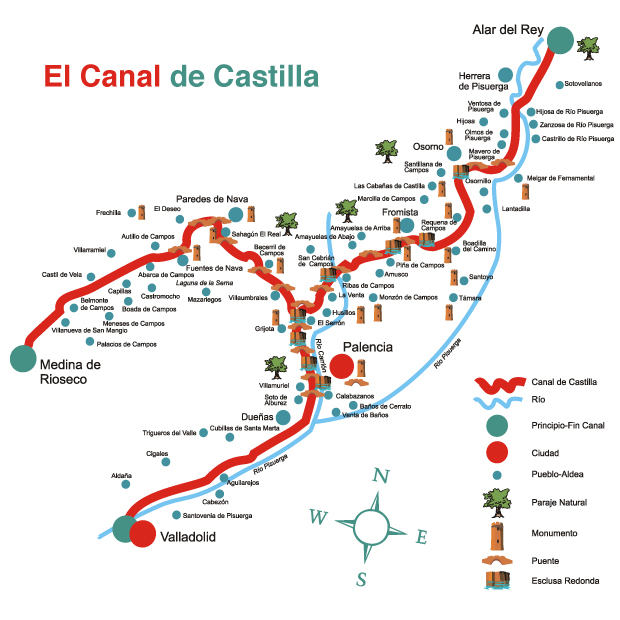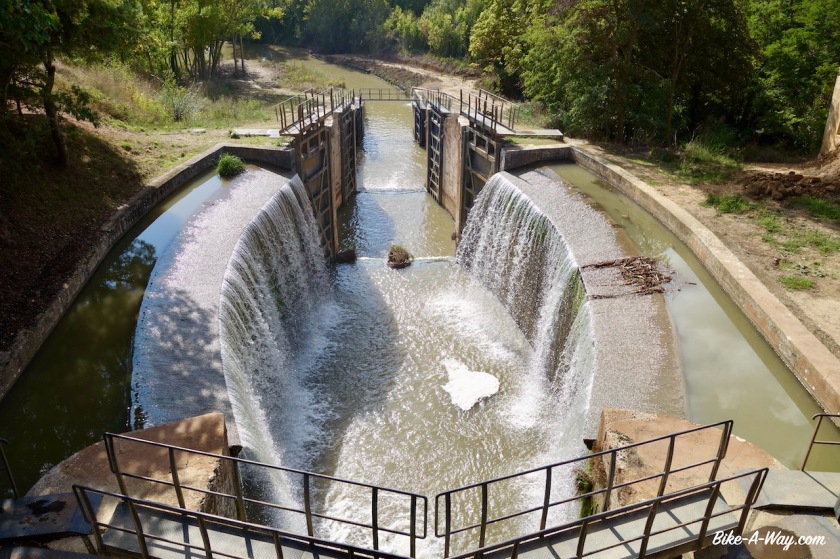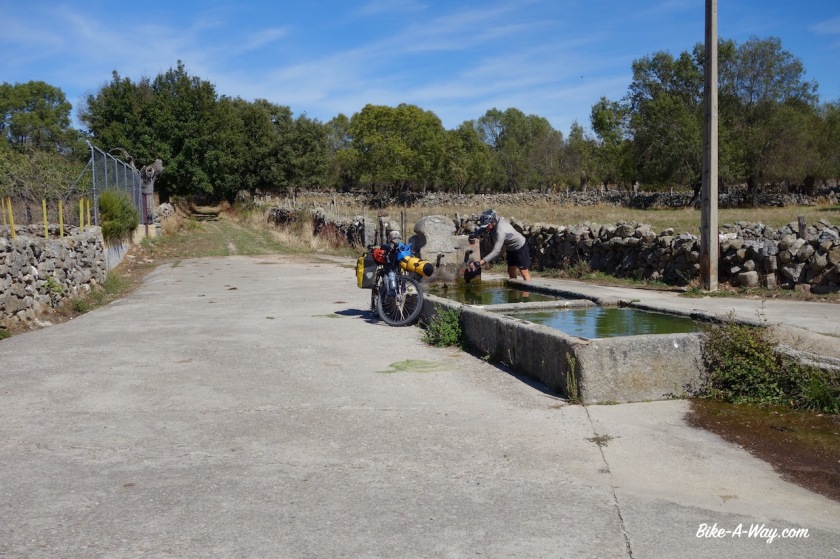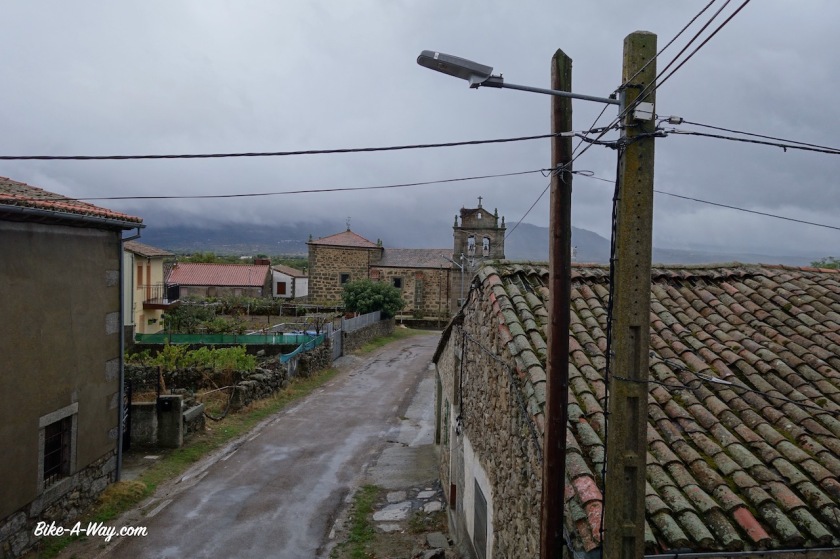Route: Valladolid – Palencia – Alar Del Rey – Medina de Rioseco – Tordesillas – Salamanca – Puerto de Béjar

Leaving Castilla y Leóns capital Valladolid, I may have found the easier terrain to cycle, along the Castilla Canal, but now the weather conditions turned against me. The weather forecast predicted seven days of almost continuous rain. The path along the canal is just gravel, so it could become a dirty mess.


The canal on my left side, I only had to look to the right for a possible camping spot. But there is the railway line from Madrid to Irun. As the sky got darker and darker, I took a right turn, away from the canal in Las Ventas, hoping to find a spot for the night. It’s all fields here and in the end I settled for a field which was recently mowed and plowed and with a line of trees protecting me for the strong winds.
Just after I pitched the tent, the downpour started, with more winds.
Next morning I found the tent to be surrounded completely by mud, the tent pegs could barely hold the tent up in the soft stuff. I packed as carefully as possible, trying to get everything more or less clean. The bike was leaning against a tree, with a flat tyre in the back. Oh, perfect, this is the exact time and place I dream of to change tubes.
I rode on to Palencia and was lucky to have a window of two hours without rain and settled down in a hotel for two nights. Went around a bit on the second day to look at the town.



Continuing along the Castilla Canal, it forks a bit after the village Grijota. I take the right fork, going north. For a while, I ride just next to the small ‘Canal de la Retencion’. Behind a line of trees, fifty meters further on runs the Canal de Castilla parallel to it. The path is muddy, spongy from all the rain. I cross the Rio Carrion, that same river I already met in the Cordillera Cantabrica, where they dammed it to create the Embalse de Camporredondo and the Embalse de Compuerto. With all these damming, diverting the water into into irrigation channels, etc…. not much is left of the natural flow of the river and I guess no serious fish life can survive that way. But I did see a polecat, or something similar from the marten family today.




I left the canal to have a look at the village of Fromista, only a kilometer or so to the west. On my ride into town I saw another cyclist coming from the opposite direction. He was riding a BMC mountainbike. Together we went to have a look at the Roman San Pedro church in town.


After a visit to the local panaderia, the small supermarket and the gas station to top of my fuel bottle, we rode together back to the canal.
The most popular Camino de Santiago, the ‘Camino Frances’ is following the Castilla Canal here for three kilometer and of course I was not really visiting Fromista or riding along the canal with another cyclist, but with my virtual self in May 2017, when I rode this stretch on my way from Galician coast to the Mediterranean Sea. You can read all about that here.



I continued north along the canal all the way to the northern terminus at Alar Del Rey, not a very appealing place with sixties styles apartment blocks of eight floors or so. After a quick refill of the water bottles and a visit to the local tiny supermarket, I headed straight back the way I came. I had seen an electricity building with a nice awning under which I thought I could pitch the tent. Lots of rain was predicted. When I arrived, the space appeared to be too small and I had to settle for something less protected. I went down some dirt paths to the river Pisuergo where I saw some trees which might give shelter, but just like the fields, all the ground between the trees had been plowed and was a bumpy, muddy mess. Good camping spots are pretty hard to find along this canal.



Apart from a few drops, rain didn’t bother me too much on the 90 kilometer stretch back to the junction where I now took the northern fork of the canal towards Medina de Rioseco. There was that climatological nuisance every cyclists hates. A head wind and it became harder and harder every day. Easy riding along canals to give the legs a rest ? Forget it !

And not only that, even though the temperatures have dropped to a few degrees above freezing at night, and don’t reach the twenties anymore during the day, an incredible amount of flies, mosquitos and wasps make life impossible when you stop. At this moment, with an intense wind outside, there are at least 50 flies on my panniers outside, just as much on the outer tent, and again that many between the outer and inner tent. This are really becoming Australian situations. This is not normal and something I have never seen anywhere in Europe, also never in Spain in the past. They also have the behaviour of the Australian bush fly, i.e., they come and sit on you, go for your eyes and ears.
It is horrible.

Two more interesting villages I visited along the canal were Becerril de Campos and Paredes de Nava. The former was apparently elected as most beautiful village of Spain in 2016. It had some nice old buildings, but I preferred the latter. More spectacular than the villages was the +/- 1,4 meter long snake I saw today.
The beautiful little town of Medina de Rioseco is the terminus of de Castilla canal.Honestly, I’m not sad it’s over.While I cannot say anything ‘bad’ about it, it was the least interesting part of this trip so far.







From Castromonte I took a little detour to La Santa Espina, to visit the monastery, built in 1147 by Doña Sancha de Castilla, the sister of King Alfonso VII. Originally it was a Cistercian abbey but nowadays it is a center for agricultural education.


Being ‘freed’ from the canal, I can start looking for camping places both sides off the road or track again. I pitched the tent in a pine forest three kilometer before Tordesillas, a place which rings a bell with everybody, no doubt.
We all remember it of course from history class ! Tordesillas is the place where in 1494 a treaty was signed between Spain and Portugal, which divided the then known non-European world (basically South America) in Spanish (Castillian) and Portugese spheres. More than five hundred years down the road we still see the effect of this, with a Portugese speaking Brazil and Spanish speaking rest of South-America.
There is a great museum with interesting maps about it all in Tordesillas.
It was closed (Monday). Sigh.

In Tordesillas I also meet the Douro River again. I follow the ‘Senda Del Duero’, a hiking trail along the river, for a while. It is not always close to the river.
The trail is mostly good, sometimes bumpy or sandy with from time to time great vistas to the river.

After crossing the river over the Presa de San Jose near Castronuño, I leave the Douro which flows towards Zamora and further on to Portugal. Me, I take a good, quiet asphalt to La Bovéda de Torro.
After this town, I made my way over some fantastic gravel further south.
I camped on a hill top, about 930 m from where one has fantastic view to the outlines of the Sierra Guadarrama and Sierra Bejar.


My mattress started delaminating near the foot end about a week ago and I urgently need a new one. I thought about taking asphalt to speed up to Salamanca, where I can find one, but first starting riding a bit more gravel roads.
Soon I was thinking “Why would I go and ride between cars and trucks when I have so much fun on the gravel ?”
The Decathlon website stated they had only one Therm-A-Rest mattress left in Salamanca, so on the one hand I was in a hurry to grab it, but on the other hand I experienced that the information on Decathlons website can’t be trusted, so I decided to give riding fun priority over buying mattresses.

Two kilometer before Salamanca, I could see the towers of the cathedral already, I had a flat. Multiple punctures from a steel wire out of a car tyre. Here in Salamanca, I cross again my own tracks, this time from April 2017. At that time there were a lot of people near the cathedral.
Now, corona times…. I was standing here all alone. I visited the cathedral this time (6 € entry fee !)
Also here, I was all alone.









Later in the afternoon, following the bike path along the Tormes River (which I crossed already a while ago on my way to Segovia), I rode to Decathlon.
A very bizar situation arose. They had one more Therm-A-Rest but refused to sell it to me first. After a whole discussion, they gave in. Bizar.
Bought new shoes, long pants to cycle and a soft shell to keep me warmer.

Riding south of Salamanca, I take the off-road Via de la Plata. I still had my own waypoints of good wild camping spots so I knew exactly where I was going.




This is a real nice stretch of the Via de la Plata and I was looking forward to ride it again. About ten kilometer after San Pedro de Rozados follows a short, steep climb (pushing required) to a hill top full of wind mills. An English lady hiking towards Santiago told me this is the highest point on the Via de la Plata. No idea wheter this info is correct.

I knew from my visit in 2017 that after tackling this hill, I would enter some land with excellent wild camping possibilities.
After that good night, I rode the short distance to Valverde de Valdelacasa and settled down in the pilgrims albergue. Lots of wind and torrential rain was predicted for the coming night.




Waking up in my room in the albergue, a quick glance through the window showed all surrounding mountains covered in thick, ugly, grey clouds and the downpour had changed the street in a river a few centimeter deep. The cleaning lady showed up before 10 am and I had to evacuate my room. The four Spanish cyclists who slept in the dormitory had left already.
“Why on earth would somebody go out in this weather ?”, I wondered.
But I’ve seen (most) people doing that before. Or I am an incredible pancake, or those people’s holiday must be calculated down to the minute and they’ve got no time to lose.
Anyway, by 11 am it was just raining instead of the earlier downpour. “Don’t be a soft potato for once”, I told myself and went out.


It was Friday. I was 36 km from the post office in Hervas and although the tracking showed the package I was waiting for since more than a month was still stuck in Madrid, I wanted to go and check whether it might have arrived by some miracle.
Not a hundred meters, really, less than hundred meters I was on my bike, and they opened all gates in the sky. What a downpour Few hundred meters further, asphalt changed in sand…. mud. After 3,8 km I noticed the rear tyre was almost flat.
“Aaah, f*%k, not now !”.
Refusing to change the tyre on the muddy road, I gave it 72 pumps and continued riding.
Exactly two kilometer further… almost flat again.
A hundred pumps this time.
I had to pump a third time before reaching the next village, La Calzada de Béjar.
“I’ll never make it before 14:30 (closing time of the post office) like this.And what’s the point, racing to a post office to collect a package which is still hundreds of kilometer away in Madrid, according to the tracking ?
“Better shelter a bit here”, I told myself, because it’s not only raining, but a real strong ice-cold storm wind is blowing from the side as well.
On the other hand, I was wet already. And what if this tracking was wrong and my package was sitting in Hervas. They only hold it for two weeks before it is returned to sender. If I don’t check, it might be on its way back to Belgium before it ever officially arrived……
I jumped back on my bike, after giving the tyre one hundred pumps.

At 14:10 I arrived at the post office with twenty minutes to spare. The last part from Béjar to Hervas is really easy over the via verde. In total, I stopped nine time to inflate the tyre.
Nonchalant, I asked the post employee for my package, as if I was sure it would be there.
Even more nonchalant, he handed it over to me.
“Break now my wooden shoe”, I thought. (But lesson learned. In future I’ll use DHL to send packages. Maybe 10 euro more expensive, but they come and collect the package at home, and they guarantee delivery almost anywhere in the world in two days. No more postal services for me).
Well, it makes life a lot easier. I rode back to the via verde verde where the former railway station has an awning under which I could replace the worn rear tyre with the new one from my package, and put another tube inside (the slime tube was way too slimy to patch). I’ve ridden about 5.000 km on the old tyre, which is not bad for a knobby tyre, on a loaded bike over rough terrain.
Time to start a new chapter of my trip in the Extremadura.
